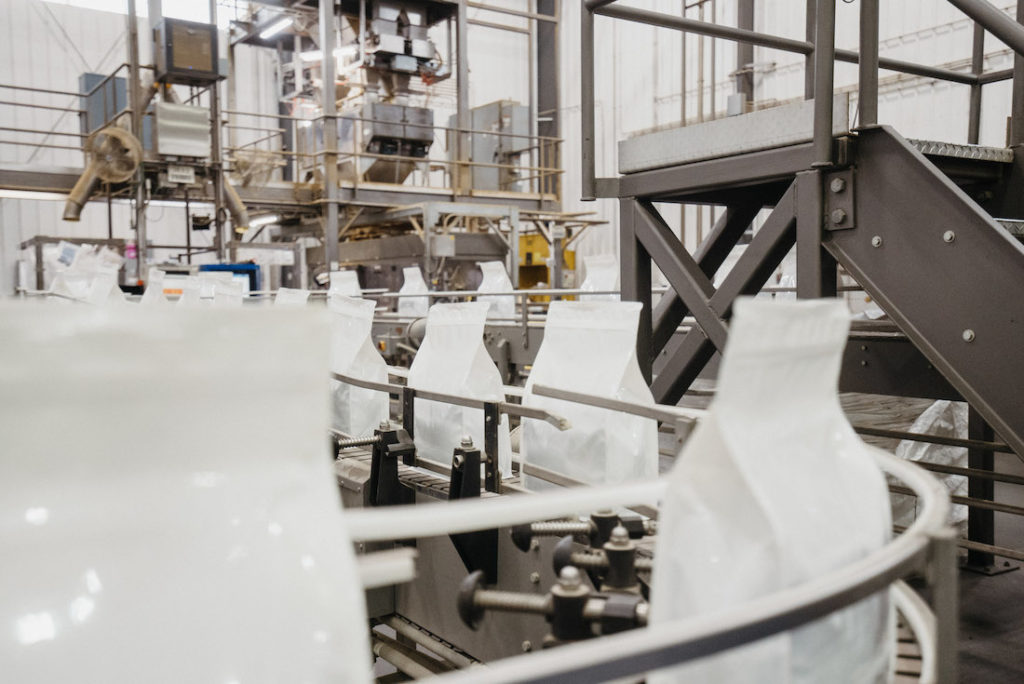Packaging is a critical aspect of pet food manufacturing. Taking shortcuts in the package design process can have costly consequences.
Being a co-manufacturer, we always try our best to accommodate customer preferences; we encourage customers to work closely with us to determine the best packaging style for each product. This approach not only leads to on-shelf success for our customers’ brands but also allows us to ensure an efficient manufacturing process. However, things don’t always go that smoothly. Below is a cautionary tale of what can happen when the manufacturer and customer aren’t fully aligned.
In this case, the manufacturer recommended flat-bottom bags, which allows for greater production efficiency on their production line. However, the customer provided pinch-bottom bags, which is a common choice among pet food brands for economic reasons. The cost of a bag is only one consideration in the total cost of ownership. As a result, the extruder outpaced the packaging line, requiring removal of excess product from the line to be packaged later. In the end, the packaging part of the process took almost three times longer than it would with flat-bottom bags. After this problematic packaging experience, the manufacturer and customer both decided to switch to flat-bottom bags.
While the bag cost is an important consideration, production efficiency and shipping durability are other crucial components. In addition, bags with premium features can boost customer perception of quality and value, driving more sales.
Start your packaging plan early
The pinch-bottom bag story illustrates the importance of starting early in the production planning process and working closely with the co-manufacturer to determine the optimum bag style and characteristics. Establishing a sound customer-supplier relationship at the beginning of a project will help lower costs and improve efficiencies in getting the finished product to the consumer.
This post highlights how the process works at Alphia.
Alphia’s packaging engineers can recommend standard designs that perform well on our equipment. The engineers’ recommendations will help customers achieve lower conversion costs, shorter lead times, and greater shelf appeal. The available bag styles are:
- Stand-up pouch for packages 1-4 pounds, a popular option for treats
- Quad seal bag with four panels for small- and large-volume bags, 10-40 pounds
- Flat bottom bag for packages 2-10 pounds offering a large design canvas
- Pinch-bottom bag—typically for larger-volume packages that retailers stack on the bottom shelf
Packaging design: In-house or turnkey?
About half of Alphia customers supply their own packaging to our production facilities. The other half relies on Alphia to manage the entire packaging design process, from requirements definition through bag manufacturing by an Alphia partner.
We typically have fewer production issues when delivering a “turnkey” packaging solution. This is because we are able to use one our proven package designs, manage the artwork and bag manufacturing with our preferred vendors, and arrange timely delivery of the finished packaging to our production facilities.
When a customer opts for the turnkey approach, the overall lead-time is reduced. We have a library of template designs for different bag sizes that are tested to work on our equipment. After the customer approves our recommended design, Alphia can work with the customer’s graphic designers or one of our graphic partners, and then manage the project to completion through our pre-press house and bag manufacturer.
Alphia’s turnkey approach cuts about four to eight weeks off the production cycle for a new bag by eliminating time-consuming steps of a customer-managed approach. These additional steps could include obtaining prototype bags from the customer’s supplier, testing the bags and reporting results to the customer, and gaining approval for any recommended modifications to the customer’s prototype bag.
Design considerations for a new product’s bag
If your company is planning a new pet food product, the key to avoiding delays, cost overruns, and other problems is to involve your co-manufacturer early in defining the product’s package design. Items to consider include:
- Bag dimensions. determine the amount of product the bag can contain and what type of equipment will be needed on the production line. Alphia can either recommend bag dimensions for packaging designs that we manage or provide a recommended design template for customer-managed projects.
- Bag characteristics. We will recommend the ideal material substrate for a new product’s bag. Is the bag strong enough? Can it pass a drop test? What are the finish characteristics (glossy or matte film, sustainability options)? We will determine how well the bag will run on our production filling equipment, conveyors and how well it will stack with automatic palletizers.
- Delivery channel. Pet food brands have seen fast growth in the ecommerce channel. Orders delivered by carriers have more touchpoints in transit and may therefore have different packaging characteristics than those sold in retail stores. For example, perhaps shelf appeal is less important and bag strength is more important.
- Consumer appeal. For high-end retail products, we can recommend the best packaging for shelf appeal, incorporate zipper or Aplix closures, and partner with a graphic designer if needed.
- Palletization. Alphia wants to ensure the finished packaging ships economically, so we examine how to optimize pallet patterns with the cost of freight.
- Suitability for export. We design packaging suitable for container shipments.
In the planning stages of a new packaged product, openness to ideas and due diligence among the pet food brand, the co-manufacturer, and the packaging supplier will eliminate the vast majority of problems.
If an issue arises, however, Alphia will aggressively take corrective actions—starting with a search for the root cause of the issue and ending with recommended solutions.
